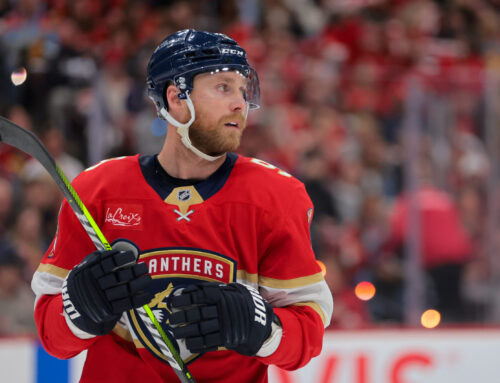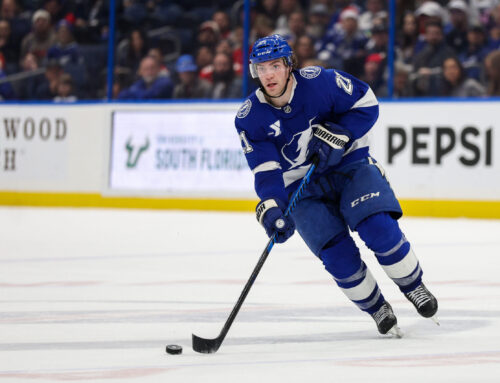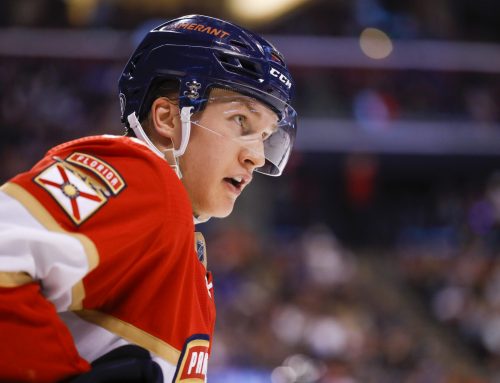
What a difference a season can make. When 2017-18 began Matt Duchene was still an Av, with poolies worried his best days were behind him even if he managed to get traded, while Ryan Johansen was the #1 center on an elite team poised to improve its offensive output. Fast forward to now, and Duchene tallied 59 points despite being traded to lowly Ottawa, while RyJo managed only 54 (down from 61 in 2016-17) even as Nashville potted 23 more goals this season versus last. Are these two at a fantasy crossroads? Let’s find out – Cage Match starts now!
Career Path and Contract Status
Johansen, 25, was selected 4th overall in 2010 but had a mere 33 points after 107 NHL games. That all changed in 2013-14 though, as he jumped to 63 points then upped his output to 71 in 2014-15. Even still, Columbus flipped RyJo to Nashville near the midway point of 2015-16, after which he responded with 34 points in 42 games as a Pred. In 2016-17 he saw his output wane a bit, although he still posted 61 points. But as noted above Johansen bled even more points in 2017-18 despite Nashville seeing its offensive output rise.
Duchene, 27, was selected 3rd overall in 2009 and made an immediate impact via 122 points in two seasons as a teen. After an injury-hampered 2011-12 though, Duchene only got better, with 113 points in 118 games in 2012-13 and 2013-14. From there, things went south for Duchene and the Avs as a team. At first his production wasn’t a huge step down (114 points in 158 games); however, things came to a head in 2016-17 when his scoring plummeted to 41 points in 77 games amid near constant trade rumors. When finally dealt this season, it looked like the change in scenery wouldn’t help, as he posted a mere six points in 19 second quarter games. However, he rallied in the second half to the tune of 43 points in his final 44 contests, once again looking a like a franchise forward and igniting hopes he’d managed to come full circle.
Johansen just finished year one of an eight-season deal that dings the cap at $8M per campaign, while Duchene makes 25% less ($6M per season) but will be a UFA after 2018-19.
Ice Time (Duchene’s 2017-18 stats here are only from his 68 Ottawa games, while Johansen’s 2015-16 stats are split between his 38 games with Columbus and 42 with Nashville)
|
Season |
Total Ice Time per game (rank among team’s forwards) |
PP Ice Time per game (rank among team’s forwards) |
SH Ice Time per game (rank among team’s forwards) |
|
2017-18 |
18:32 (R.J.) – 1st 18:51 (M.D.) – 2nd |
3:02 (R.J.) – 1st 2:44 (M.D.) – 4th |
1:02 (R.J.) – 8th 0:11 (M.D.) – 10th |
|
2016-17 |
18:50 (R.J.) – 1st 18:18 (M.D.) – 3rd |
2:55 (R.J.) – 1st 2:30 (M.D.) – 3rd |
0:47 (R.J.) – 8th 0:57 (M.D.) – 7th |
|
2015-16 |
17:20 (R.J. – CBJ) – 3rd 17:45 (R.J. – NSH) – 3rd 18:35 (M.D.) – 3rd |
2:58 (R.J. – CBJ) – 1st 2:40 (R.J. – NSH) – 3rd 2:48 (M.D.) – 3rd |
0:20 (R.J. – CBJ) – 9th 0:01 (R.J. – NSH) – 12th (tied) 0:11 (M.D.) – 12th |
|
2014-15 |
19:30 (R.J.) – 1st 18:34 (M.D.) – 2nd |
2:52 (R.J.) – 1st 2:18 (M.D.) – 6th |
1:20 (R.J.)- 7th (tied) 0:09 (M.D.) – 9th |
Seeing Johansen’s ice times for this season and last, there’s no apparent explanation for his diminishing production. After all, he was team leader among forwards in overall and PP Ice Time in both campaigns. Moreover, although he’s been plugged into shorthanded duty somewhat, that also occurred in 2014-15 when he posted his career high (to date) of 71 points. Glass half full poolies could come away relieved that even as his production has slipped and Kyle Turris has arrived RyJo is still seemingly the team’s unquestioned top pivot, while pessimistic poolies could point to the lack of ice time explanation for his dip in production as concern he simply might not be the same player he once was or many thought he’d be as Nashville’s offense opened up.
Looking at Duchene’s ice times, it’s difficult to see how/why he cratered to 41 points in 2016-17. But at least in his case it was amid rampant trade rumors and while playing for a team which scored only 165 total goals, which, to put things in perspective, tied for the third lowest output among any NHL team from 2013-14 through 2016-17, i.e.., 117th out of 120. So that right there is some justification.
Where concern might more rightfully arise is in looking at Duchene’s 2017-18 ice times and seeing how they weren’t much better than these other three seasons, yet he managed to play nearly point-per-game hockey over his final 44 games. There’s some solace, however, in that when he posted 70 points in 71 games in 2013-14 he averaged 18:29 per game, with 2:43 of that coming on the PP; or in other words, numbers very similar to this season. Thus, unless Duchene was unsustainably lucky this season, his elite scoring could stand to be repeated or even improved upon as Ottawa gets better as a team.
Duchene also has favorable player comparisons dating back to his early seasons. Since 2000-01 only ten other centers appeared in 325+ games while cumulatively averaging 0.78+ points per game, all by age 24. The lowest single season career best among them is 76 (Jonathan Toews), but each of the rest has posted 84+ points in a season. That being said, only one (Anze Kopitar) hit the 84 point mark when older than Duchene is now, and in Kopitar’s case he’d posted 81 points in a season by age 22. While none of this is predictive data, it is interesting food for thought.
Secondary Categories (Here, Johansen’s 2015-16 numbers have been consolidated, as has Duchene’s 2017-18 data)
|
Season |
PIMs (per game) |
Hits (per game) |
Blocked Shots (per game) |
Shots (per game) |
PP Points (per game) |
|
0.98 (R.J.) 0.22 (M.D.) |
1.10 (R.J.) 0.73 (M.D.) |
0.44 (R.J.) 0.59 (M.D.) |
1.62 (R.J.) 2.31 (M.D.) |
0.19 (R.J.) 0.16 (M.D.) |
|
|
2016-17 |
0.73 (R.J.) 0.15 (M.D.) |
0.94 (R.J.) 0.54 (M.D.) |
0.34 (R.J.) 0.53 (M.D.) |
1.88 (R.J.) 2.07 (M.D.) |
0.28 (R.J.) 0.11 (M.D.) |
|
2015-16 |
0.76 (R.J.) 0.31 (M.D.) |
1.43 (R.J.) 0.54 (M.D.) |
0.37 (R.J.) 0.48 (M.D.) |
2.31 (R.J.) 2.63 (M.D.)
📢 advertisement:
|
0.29 (R.J.) 0.19 (M.D.) |
|
2014-15 |
0.48 (R.J.) 0.19 (M.D.) |
1.02 (R.J.) 0.52 (M.D.) |
0.40 (R.J.) 0.90 (M.D.) |
2.46 (R.J.) 2.52 (M.D.) |
0.31 (R.J.) 0.08 (M.D.) |
Although RyJo is still providing solid output in both PIM and Hits, his SOG and PPP rate have declined for three straight seasons (actually four in SOG, going back to 2013-14). There’s no way to spin data as clearly negative trending as that, and quite frankly it paints a picture of a player who – whether due to lost focus, lost talent, or no longer putting forth the necessary effort – is simply is a shell of his former fantasy self. What’s more, this is all occurring while RyJo is in his prime and receiving top deployment. Of course there’s no telling how long that deployment might continue, since although Nashville likely doesn’t want to rock the boat given its success, the reality is the team has another offensively talented pivot in Kyle Turris who seemingly could be thrust into RyJo’s role, in which case Johansen’s production could suffer even more.
As for Duchene, unlike with ice time here we see clearer evidence as to why he slumped in 2016-17. Also, while his SOG rate rebounded only to 2.31 this season, it was 2.45 with Ottawa and 2.52 during his red hot final 44 contests. Beyond that, although Duchene’s PP output this season was lackluster, he tallied ten of his 13 PPPts in his last 44 games, or 0.22 PPPts per game. And even in his nearly point-per-game 2013-14 campaign his PPPt rate was only 0.24 per game, so he’s shown he doesn’t need more than that to be a top producer. In addition, him garnering only the fourth most PP Time among Sens forwards is not an issue since they’re among NHL teams which use a 4F, 1D unit for their PP1.
Luck-Based Metrics
Johansen’s data for 2015-16 has been combined except for ASD and Secondary Assists Percentage, where the top number is Columbus and the other is Nashville, while Duchene’s 2017-18 data combines his games with Colorado and Ottawa except, likewise, his ASD and Secondary Assist Percentage, where the top number is Colorado and the other is Ottawa.
|
Season |
Personal Shooting % |
Team Shooting % (5×5) |
Individual Points % (IPP) |
Offensive Zone Starting % (5×5) |
Average Shot Distance |
Secondary Assists % |
|
2017-18 |
11.6% (R.J.) 14.2% (M.D.) |
8.31% (R.J.) 8.64% (M.D.) |
56.8% (R.J.) 73.8% (M.D.) |
54.8% (R.J.) 50.0% (M.D.) |
25.1 (R.J.) 28.1 (M.D.) 24.6 (M.D.) |
56% (R.J.) 16% (M.D.) 34% (M.D.) |
|
2016-17 |
9.1% (R.J.) 11.3% (M.D.) |
7.68% (R.J.) 6.34% (M.D.) |
67.0% (R.J.) 75.9% (M.D.) |
54.4% (R.J.) 44.2% (M.D.) |
27.5 (R.J.) 24.6 (M.D.) |
40% (R.J.) 39% (M.D.) |
|
2015-16 |
7.6% (R.J.) 15.0% (M.D.) |
8.53% (R.J.) 8.47% (M.D.) |
69.0% (R.J.) 72.8% (M.D.) |
50.9% (R.J.) 57.5% (M.D.) |
31.4 (R.J.) 27.0 (R.J.) 25.4 (M.D.) |
45% (R.J.) 46% (R.J.) 45% (M.D.) |
|
2014-15 |
12.9% (R.J.) 10.1% (M.D.) |
8.59% (R.J.) 10.25% (M.D.) |
70.3% (R.J.) 73.3% (M.D.) |
48.6% (R.J.) 46.6% (M.D.) |
30.8 (R.J.) 25.4 (M.D.) |
46% (R.J.) 44% (M.D.) |
What jumps off the page is Duchene’s 72.8%+ IPP in each campaign. In fact, he’s been at 72.8%+ in his last six seasons, with a 75% or higher IPP in three of the six. A quick (but non-exhaustive) review by me revealed only two star players who’ve had 70%+ IPP for each of the last six seasons: Steven Stamkos and Patrick Kane, which is some pretty fine company to be in.
Simply put, such a consistently high IPP means Duchene is an elite player who finds a way to factor into scoring when on the ice, even as his OZ% and shooting percentages would vary. You cannot fake your way to that kind of consistent IPP, and to me it – plus, as noted above, how poorly the Avs scored as a team – easily erases lingering concern about his terrible production in 2016-17. Beyond that, he had his lowest secondary assists rate in 2017-18 among these four seasons and one which was identical to his nearly point per game 2013-14 campaign. From where I sit, that’s a good sign.
Meanwhile, as if RyJo bleeding PPPts and SOG wasn’t bad enough, his IPP has dropped in each of these seasons and, in fact, was down for a fourth straight season dating back to 2013-14. That lends still further support to the idea that RyJo is not as dialed into offense as he once was and might not be a sure bet to tally 60+ points again, let alone the 70+ we once thought he’d be able to perennially post.
On the plus side, at least Johansen’s ASD is down along with his SOG total; so although he’s shooting less, he’s being more selective about his shot choices, helping his goal total stabilize over the past few seasons rather than dropping further. Yet we also see that not only did 2017-18 mark a low for him in scoring and IPP, but he likely lucked into some of the points he managed to score in the form of more secondary assists than primary. Beyond that – as his points have been dropping, his OZ% has risen with each passing season. This really is the fantasy equivalent of a trainwreck in progress.
Who Wins?
Although he only righted his ship for 44 games this season, Duchene has favorable player comparables as well as a past highlighted by an amazing six consecutive seasons of 72.8%+ IPP, which is a star track record. Moreover, poolies can feel comfortable writing off his disappointing 2016-17 campaign, which we now know came for a team which ranked 117th out of 120 in goal scoring from 2013-14 to 2016-17. Between these factors and Duchene playing for a UFA deal this coming season, he should be a good bet for 70+ points, with a chance at even more if Ottawa does better or he can continue his full momentum from the second half of 2017-18. All this, plus his likely lower cost to obtain – in draft or trade – than Johansen, makes him the victor in this match, and by a pretty wide margin unless your league places a premium on PIM and/or Hits.
As for Johansen, wherever we look the data and outlook are bad. In my nearly five years of doing Cage Match I’m not sure I’ve ever seen such clear negative trends for a player. The good news is that if Nashville keeps him in his #1 center role it can’t get much worse, and could even improve if he finds a way to turn the tides; however, I think the odds are stacked against him living up to his former fantasy potential and perhaps even tasting even 60 points again. I cannot see him being a good cost vs. value player to own going forward, especially in cap leagues.





 TOR
TOR S.J
S.J ANA
ANA EDM
EDM CAR
CAR DET
DET CGY
CGY VAN
VAN BOS
BOS
